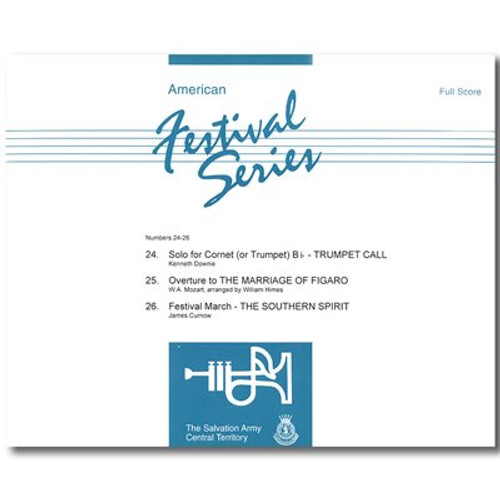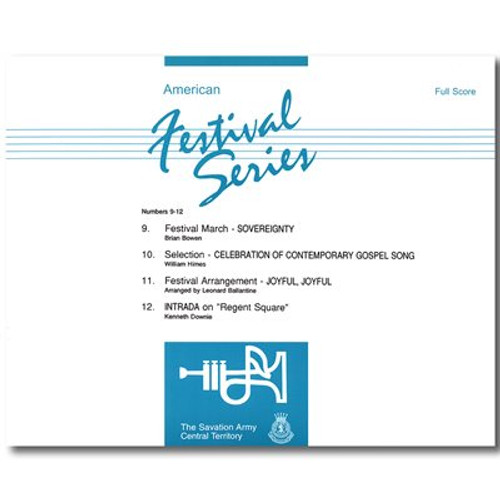Product Description
December 1999 Nos. 24-26
Brian Bowen, editor
Comments by
Staff Bandmaster William Himes
Music & Gospel Arts Secretary, USA Central Territory
Score Sample(view series guide)
24. Solo for Cornet Bb - Trumpet Call Kenneth Downie Notes 25. Overture to The Marriage of Figaro W.A. Mozart, arr. William Himes Notes 26. Festival March - The Southern Spirit James Curnow Notes
Produced by The Salvation Army - Central Territory24. Trumpet Call
(sample music)Program Note:
This colorful solo takes the theme "Stand up for Jesus" as the basis for this dramatic essay for cornet and band.Note to the Conductor:
This technical essay for cornet and band will be a welcome addition to solo repertoire as it is neither a variation nor tone solo.
The key to effective interpretation and performance is to take the composer's expression markings quite literally - particularly where crescendos and diminuendos are concerned. (See bars 8, 21 and 81 as examples.) Otherwise, this piece is quite straightforward and, typical of this composer, abounding in melodic and rhythmic interest with a warm, resonant orchestration.25. Overture to The Marriage of Figaro
Program Note:
Completed in early 1786, this delightful work was premiered in Vienna. The vivacious spirit of the music was a fitting prelude to the sparkling comedy which was to follow, although the composer made no attempt to connect the overture thematically with the opera itself.Note to the Conductor:
Although this arrangement is scored for brass band, conductors should always keep the original orchestral concept in mind, striving for an elegant, light approach to this compact masterwork.
Be faithful to the terrace dynamic style so typical of Mozart's era. Unless otherwise indicated, dynamic changes should shift suddenly from piano to forte without the hint of a crescendo.
Speaking of forte, conductors are advised to set this level carefully at the outset, taking care to avoid anything blatant or overstated. This has the added advantage of leaving something in reserve when the occasional fortissimo is called into play.
When staccato is indicated, strive for well-rounded tones with detached style.
A few specific points should be made:
Intro: Pianissimo is the goal! Players must not confuse speed with volume.
Bars 41-46: Although they may not seem unimportant, be certain the half notes (minims) in the flugel/horn parts are full-throated and confident against the dominant melodic pulse of the cornets/trombones.
Bars 49-54: (and elsewhere): First and second cornets must reinforce the flugel/horn fp attack without being too obvious.
Bars 57-61: Note the accented attacks on beat two also include tenutos. These chords should be at once resonant and shimmering!
Bars 67-76: (and elsewhere): Although the quick articulations in the solo cornet part are presented in alternating fashion, the section may choose to play this in its entirety without alternation - as long as breath control and stamina permit!
Bars 89-104: Much is expected of the first cornet here (and if possible, marimba) in terms of agility and steadiness. Nevertheless this passage (with the addition of flugel a few bars later) must should light and effortless - a background to the melody found in the horn section. The same is true when the horn section provides the same accompaniment when this theme returns in bars 194-209.
Bars 210-225: This exciting transition to the final section will require careful rehearsal in order to mold the many eighth-note (quaver) entries into a long, cohesive melodic line.
Bars 226-end: The conclusion should exemplify energy and resonance. The trills in bar 237 should be vigorous, followed by bold, striking chords that are well-rounded and balanced. Let the first cornets and first/seconds trombones come to the fore in bars 244-250, with the entire band bringing the final five bars to a brilliant yet sonorous finish.26. Festival March - The Southern Spirit
Program Note:
Written to honor Commissioners Andrew and Joan Miller on the occasion of their farewell as leaders of The Salvation Army's Southern Territory, this march abounds in motivic and rhythmic interest, using as its primary theme the well known Southern hymn tune, "How firm a foundation."Note to the Conductor:
Bands will find this fine march to be lyrical and inventive - yet generally quite accessible. Because the composer is quite thorough in his score directives, little else is needed in the area of technical comments. Suffice it to say, it is important to keep stylistic distinctions between the lyrical legato melodies and the marcato contrasting sections. The march comes to a brilliant conclusion (and even includes a judicious reference to "Dixie.")








